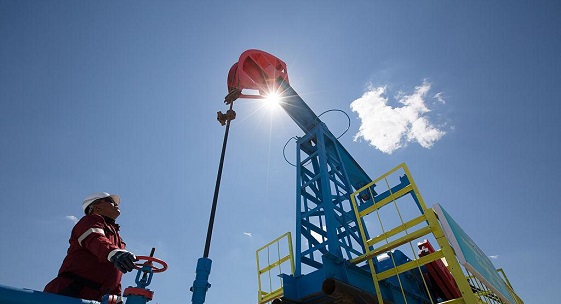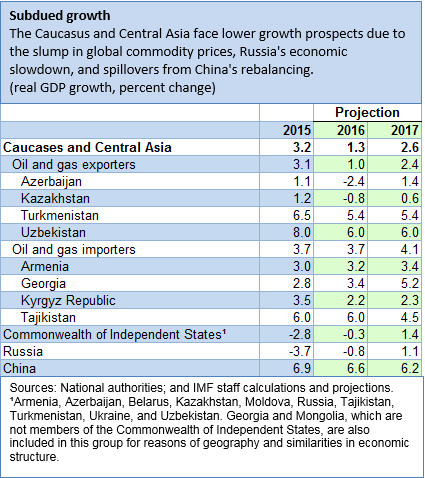
Worker performs maintenance at an oil field near Atyrau, Kazakhstan. Oil exporters in the region continue to face challenges due to low oil prices (photo: Andrey Rudakov/Bloomberg via Getty Images)
Need for Reforms Intensifies Amid Weak Growth in Caucasus, Central Asia
October 21, 2016
- Low commodity prices and slowdown in key economic partners—Russia and China—continue to weaken growth
- Monetary and financial policies, structural reforms needed to improve economic prospects
- Reducing dependence on remittances and commodity exports vital for sustainable growth
The Caucasus and Central Asia (CCA) is embarking on one of its slowest economic recoveries since independence, the IMF announced this week, as the region continues to battle the effects of a number of large and persistent external shocks.
Related Links
The IMF’s Regional Economic Outlook for the Middle East and Central Asia, officially launched on October 19 in Dubai and October 21 in Almaty, forecasts the region’s growth in 2016 to be 1.3 percent, lower than at any other year since 1998.
This growth rate is particularly being weighed down by the region’s oil exporters—Azerbaijan, Kazakhstan, Turkmenistan, and Uzbekistan—who are facing growth of 1 percent this year, according to the IMF. The region’s oil importers—Armenia, Georgia, the Kyrgyz Republic, and Tajikistan—are forecast to grow at 3.7 percent, unchanged from 2015.
The IMF says the region's growth overall will rebound to 2.6 percent in 2017 (see table).
In subsequent years, growth is projected to improve further, but the IMF expects that recovery to be slower than either of those that followed the 2009 global financial crisis and the 1998 Russian financial crisis.
Should that happen, the region could see growth in its living standards decelerate over the medium term compared with other emerging markets and developing economies.
Persistent external shocks
The Deputy Director of the IMF’s Middle East and Central Asia Department, Juha Kähkönen, said that while the region is being held back by factors outside its control—the slump in global commodity prices, including crude oil and natural gas, subdued economic conditions in Russia, and slowing growth in China—these developments have only intensified the need for further monetary and financial policy actions, as well as key structural reforms.
“The CCA region is at an important juncture, and policymakers need to take important steps toward promoting strong and inclusive growth and job creation, much needed to preserve and improve living standards,” Kähkönen told reporters in Almaty, Kazakhstan.
“The protracted nature of these shocks underlines the pressing need to diversify these economies away from their dependence on remittances and commodity exports, so they can more effectively cope with the kinds of economic challenges they’re currently facing,” he added.
To this point, the region’s countries have used a mix of public spending and currency adjustment to cope with the drop in commodity prices and the economic slowdowns in key trading partners.
However, according to the IMF, amid weak revenues, budget deficits have widened some 6.4 percentage points of GDP between 2014 and 2016—and public debt has increased.
Currency adjustment, and in some cases increased exchange rate flexibility, has helped cushion the effect of the shocks on external and fiscal balances, while also supporting competitiveness.
However, currency adjustment has temporarily raised inflation in a number of countries and added to vulnerabilities in the region’s highly dollarized financial sectors, as reflected by downward pressures on asset quality, and lower bank lending and borrowing.
Structural transformation needed
Kähkönen said that to address the legacy of the external shocks, the CCA countries need to pursue the right mix of policies and structural reforms.
“For these countries, the immediate priorities are to direct what spending is available toward pro-growth areas—such as education, training, and health care. At the same time, these countries need to prepare and implement medium-term fiscal consolidation plans to preserve fiscal space,” Kähkönen said.
To reap the benefits of needed increased exchange rate flexibility, policymakers should strengthen their monetary policy frameworks by adopting credible nominal anchors and enhancing the independence of central banks. At the same time, there is a need to bolster financial sector oversight and crisis management policies, the report said.
“All these actions will help to support growth in the near term, while boosting competitiveness and keeping inflation and debt levels in check,” Kähkönen noted.
Beyond that, however, Kähkönen said the Caucasus and Central Asian countries need to undertake wide structural reforms of their economic models, especially to strengthen governance, accountability, property rights, and financial intermediation, all of which are areas the region lags behind other emerging markets.
“This is crucial for helping to boost growth over the medium and longer term,” he said.
The report highlights that many countries have drawn up diversification and privatization plans, and emphasizes that the focus must now turn to implementing these plans decisively, transparently, and thoroughly.
“The success of these measures will allow the region to enjoy more sustained and inclusive growth, which will improve living standards and lower poverty rates,” Kähkönen said.








